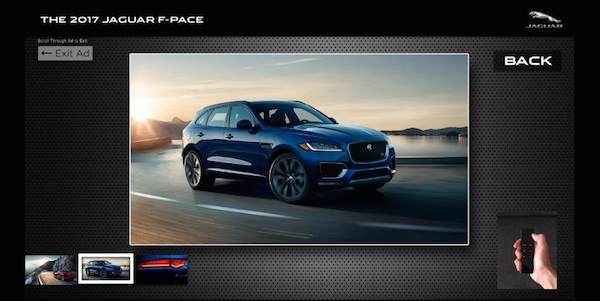
The Washington Post has started running its first interactive ad on Apple TV. The ad, for Jaguar, consists of a 30-second commercial. The interactive part is that below the commercial are panels that the viewer can click on using their remote to see photo galleries of the inside and outside of Jaguar’s F-Pace.
The ad has been live for two weeks and the Post wouldn’t share engagement rates except to claim they’re higher than pre-rolls ads that run on websites.

“Our viewers haven’t seen this before,” said Anthony DeMaio, vp of global advertising for the Post. “There aren’t a lot of companies creating interactive ads in the marketplace.”
Old-fashioned TV viewing still dwarfs digital TV, but is projected to level off as people shift their attention from live TV to streaming on their desktops or connected TVs like Apple’s, according to eMarketer. Apple made it possible for media companies to publish to its Apple TV app store a year ago, and the Post uploads 20 videos a day there, representing the scope of its editorial coverage.
DeMaio wouldn’t say how many people have downloaded The Washington Post’s Apple TV app through which they can access Post videos, but maintained the audience on it is “growing steadily. We’re in the early days but as we move forward it will be an area of concentration for us.”
The Post used video ad firm Velocity Made Good to build the Jaguar ad, using VMG’s product called Avalanche. By being interactive, the idea is that they can give advertisers a way to gauge viewers’ interest in the product and command a premium price, even over regular preroll ads.
Whether people want interactive ads in the first place is still a question. There’s research showing that interactive video ads outperformed preroll ads on connected TVs. The Avalanche ad was built to stop running after 15 seconds if there’s no sign the viewer is engaging with it. This “escape hatch” should cap the annoyance factor, said Chris Batty, a former Gawker Media ad sales exec who founded VMG.
“The big question is, what do our readers think,” DeMaio acknowledged. “Is this something they’ll be interested in, or is this something that will be disruptive?” Not surprisingly, he said he’s confident the format will grow in importance as time goes on, based on the early results.
More in Media

Here are the biggest moments in AI for publishers in 2025
Here are some of the moments that defined how publishers adapted to the AI era this year.

Digiday+ Research roundup: Gen Z news consumption and diversification in the DSP space were 2025’s top trends
As 2025 winds down, we rounded up the biggest trends of the year, based on the data that resonated the most with Digiday’s readers.

What publishers are wishing for this holiday season: End AI scraping and determine AI-powered audience value
Publishers want a fair, structured, regulated AI environment and they also want to define what the next decade of audience metrics looks like.





